Documentation
This solar load validation case belongs to fluid dynamics and heat transfer including solar radiation. This test case aims to validate the solar load model on a small airbox. The results obtained from the simulation were compared to the analytical solution. The parameter that was compared is:
The geometry of the airbox has the following dimensions:
The top surface has a fixed temperature and the side walls are set adiabatically. The bottom surface is the wall for which the temperature is to be calculated and compared. The solar load is applied in the normal direction of the wall.
Tool type: OpenFOAM
Analysis type: Incompressible Conjugate Heat Transfer with radiation
Turbulence model: \(k-\omega\) SST turbulence model
Time dependency: Steady-state
Mesh and element types: The mesh was created using SimScale’s standard mesher. The box has 13,000 cells and a boundary layer mesh on the wall surface.
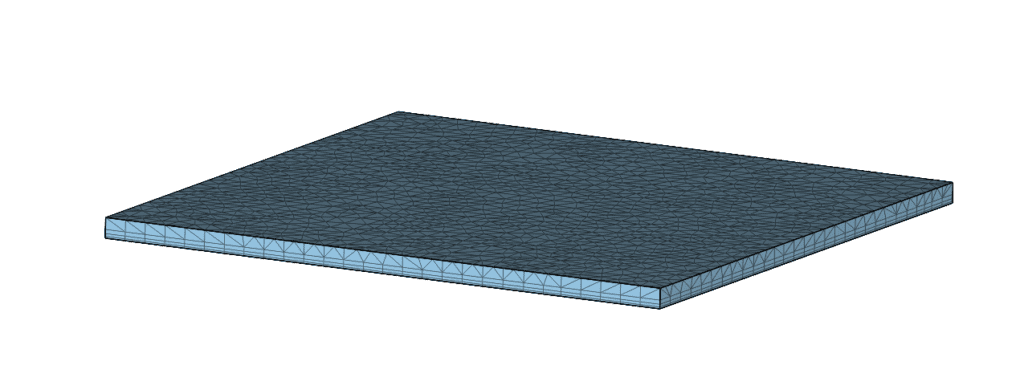
Material:
Boundary conditions:
Top and side surfaces:
Wall without thermal wall modeling:
Wall with thermal wall modeling:
Side Walls: Adiabatic
For the validation of the solar load, the analytical solution for the wall temperature was calculated using the following equations\(^1\):
Equations for heat flux from ambient to wall and heat flux from wall to top:
$$ q_{Ambient To Wall} = (T_{Wall}-T_{A}) * h \ – q_{SolarDiff} * \epsilon \tag{1}$$
$$ q_{Wall To Top} = (T_{T}-T_{Wall}) * {\frac{\kappa_f}{h_f}} + q_{SolarDir} * \epsilon \tag{2}$$
Continuity of heat flux:
$$ q_{Ambient To Wall} = q_{Wall To Top} \tag{3} $$
Put equation 1 and 2 into equation 3 and solve for \(T_{Wall}\)
$$ T_{Wall} = \frac{1}{h + \frac{\kappa_f}{h_{f}}} \left( T_{T} * \frac{\kappa_f}{h_{f}} + T_{A} * h + (q_{SolarDiff} + q_{SolarDir}) * \epsilon \right)\tag{4} $$
Where,
For the validation of the solar load, the analytical solution for the wall temperature was calculated using the following equations:
$$ q_{Ambient To Wall} = (T_{Th}-T_{A})*h- q_{SolarDiff}*\epsilon \tag{5} $$
$$ q_{Wall To Top} = (T_{T}-T_{Wall})*\frac{\kappa_f}{h_f} + q_{SolarDir}*\epsilon \tag{6} $$
Calculation of the thermal wall temperature:
$$ T_{Th} = T_{Wall}*(1-\lambda)+\lambda*T_{A} +q_{SolarDiff}*\frac{\epsilon}{h+\frac{\kappa_{tw}}{h_{tw}}} \tag{7}$$
Calculation of \(\lambda\) from the setup of the thermal wall:
$$\lambda = \frac{h}{h+\frac{\kappa_{tw}}{h_{tw}}}\tag{8}$$
Continuity of heat flux:
$$q_{Ambient To Wall} = q_{Wall To Top} \tag{9}$$
Equation 5, 6, 7, 8 into Equation 9 and solving for \(T_{Wall}\)
$$ T_{Wall} =\frac{1}{(1-\lambda)*h+\frac{\kappa_f}{h_f}} \left(-h * \left( (\lambda -1) * T_{A} + q_{SolarDiff} * \frac{\epsilon}{h+\frac{\kappa_{tw}} {h_{tw}}}\right) + T_{T} * \frac{\kappa_f}{h_f}+\epsilon * \left( q_{SolarDiff}+ q_{SolarDir}\right) \right) \tag{10}$$
Where,
Comparison of the analytical results to the results obtained from SimScale simulation for the surface temperature:
| Case | Analytical Result \([K]\) | Simulation Result \([K]\) | Deviation \( [\%] \) |
|---|---|---|---|
| No thermal Wall Modeling | 343.3 | 343.55 | 0.072 |
| Thermal Wall Modeling | 351.67 | 351.66 | 0.002 |
Convergence of the wall temperature without thermal wall modeling:
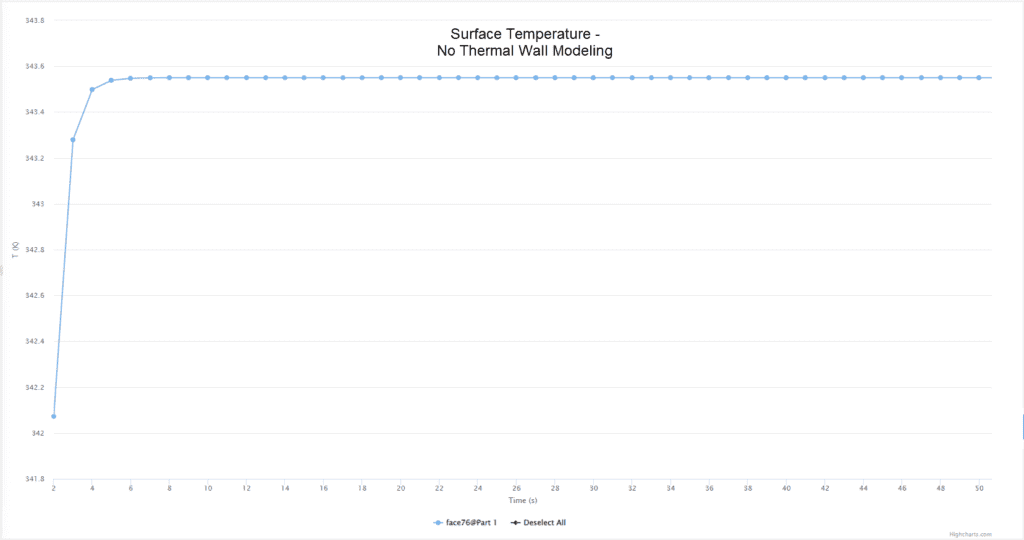
Convergence of the wall temperature with thermal wall modeling:
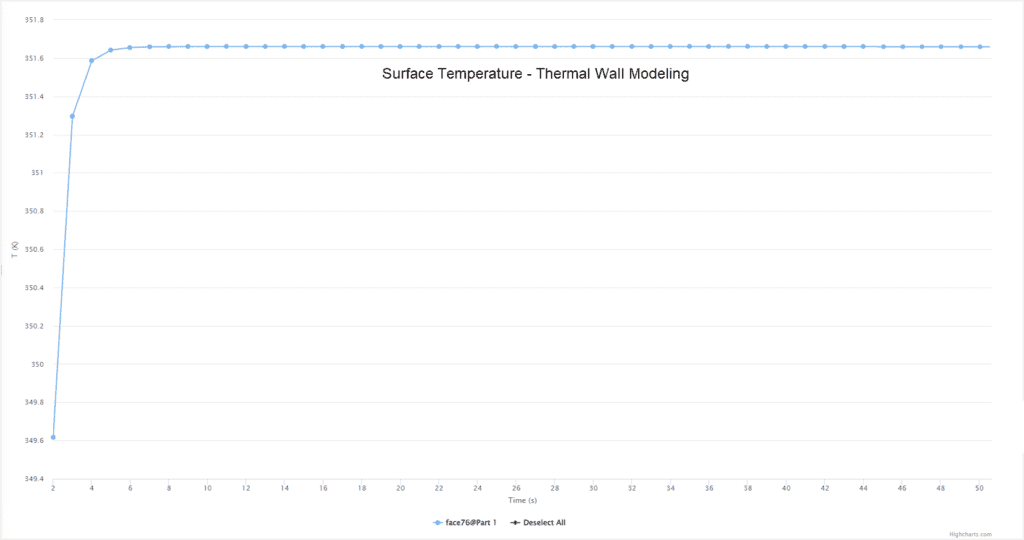
Next, we take a look at the temperature distribution on the walls of the airbox:
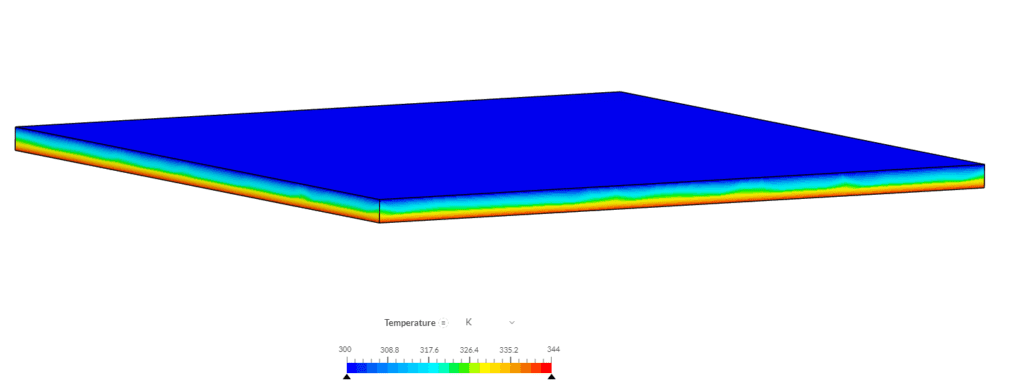
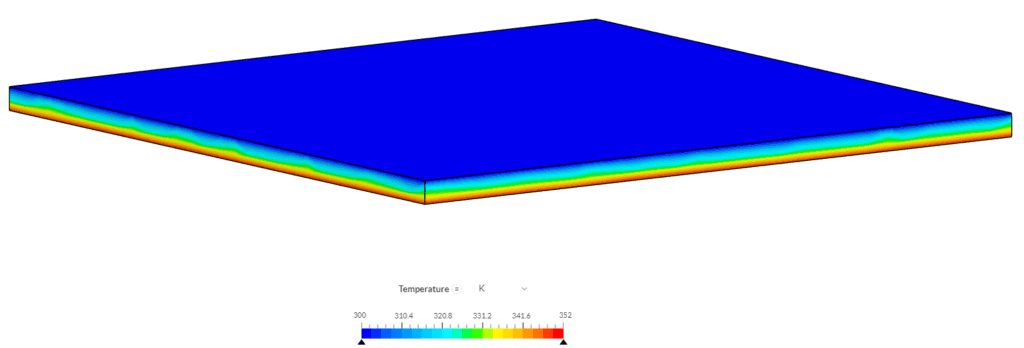
Overall the results obtained from the SimScale platform are in good agreement with the analytical solutions, and hence this serves as a good solar load validation for this feature.
Last updated: June 9th, 2022
We appreciate and value your feedback.
Sign up for SimScale
and start simulating now